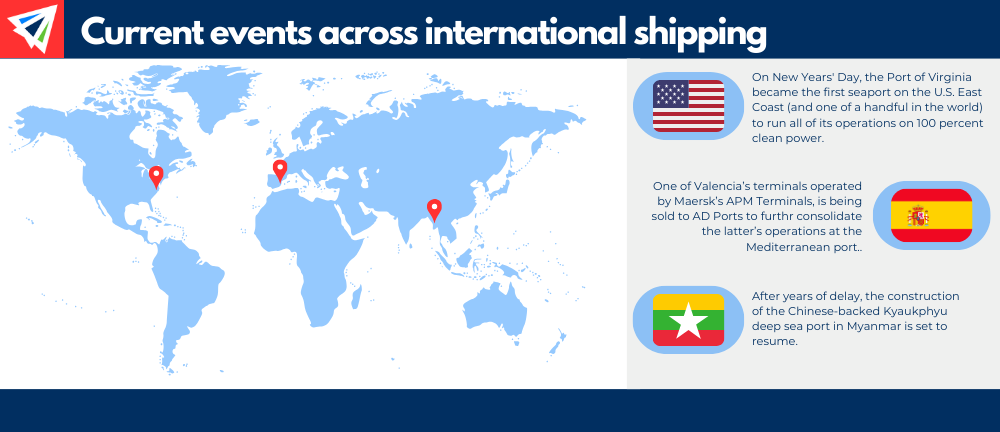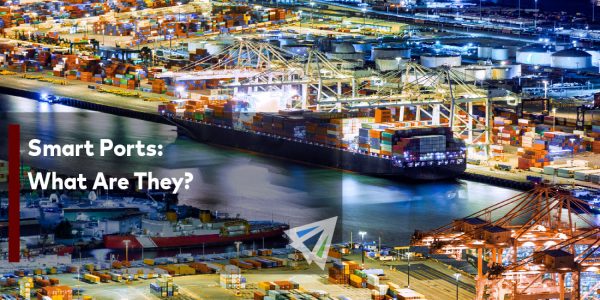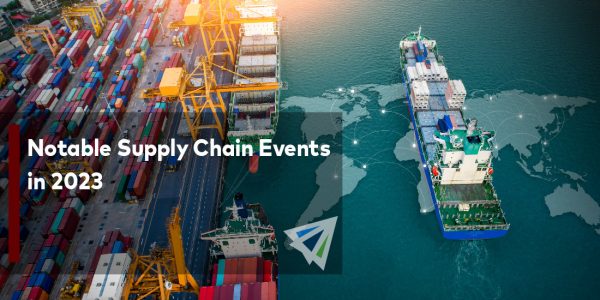Competitive Edge
January 10th, 2024
Stay Current with InterlogUSA
Latest Industry Happenings and Market Updates:

IMPORT: Asia to North America (TPEB)
Recent Developments:
- Major carriers implemented general rate increases (GRIs) on January 1. These increases are in play for most services from Asia to all U.S. coasts. In some cases, rates have risen as much as $1000 per 40-foot container unit.
- New surcharges have also been imposed on transits through the drought-hit Panama Canal.
- Eastbound services from Asia remain challenged as carriers indefinitely withdraw ships from transiting the Suez Canal amid rebel attacks on commercial vessels. As a result, the longer, bypass, routing around Africa will increase transit times, raise rates, and tighten capacity on weekly services.
Rates: Rates are elevated following New Year’s Day GRIs. Longer transits (avoiding the Suez) will increase shipping demand measured in ton-miles (volume multiplied by distance), a factor which can propel rates further upward.
Space: Space is generally loose but has seen some tightening amid external supply chain events.
Capacity: Longer transits averting the canals will absorb vessel capacity in order to maintain weekly services.
Equipment: There are no outstanding equipment deficits or bottlenecks.
TIPS:
- Hold your logistics partners accountable for frequent updates regarding current market conditions and routing impacts.
- Be flexible and adaptive to alternative service options, especially as it relates to potential savings on cost or transit.
- Establish a firm timeline for future import activity as well as a vetted pool of multiple logistics providers.
IMPORT: Europe to North America (TAWB)
Recent Developments:
- The European Union’s Emissions Trading System (EU ETS) went into effect on January 1. The program requires ocean carriers to report their CO2 emissions and submit an allowance per ton of CO2 emitted.
- Ocean carriers are implementing ETS surcharges onto trade lanes to and from E.U. countries to cover these newfound costs. While these surcharges are subject to change, refer to our blog for estimates on what certain carriers will be charging.
Rates: Rates are steadily rising, however they’re not as high as they were in early December. Low demand continues to anchor levels from any drastic increases.
Space: Space is open.
Capacity: Capacity remains in excess. However, carriers have finally taken steps to address overcapacity by reducing the size of vessels operating on transatlantic lanes. However, more aggressive measures, like blank sailings, have not been significantly deployed.
Equipment: Availability on both origin and destination sides, unless advised otherwise.
TIPS:
- Book at least three weeks prior to the ready date.
- Communicate with your logistics partners to ensure that you’re up to speed on the EU ETS program and its evolving impacts on transatlantic trade.
EXPORT: North America to Asia
Rates: Rates are low and level.
Capacity: Space remains open, particularly from West Coast ports, however exporters continue to see carriers curb their capacities via blank sailings and slow steaming as U.S. import demand remains challenged.
Equipment: Barge services in China will be temporarily suspended in early February due to this year’s Chinese New Year holiday.
TIPS:
- Insufficient communication with sailing schedules can lead to higher detention and demurrage fees as well as higher trucking and storage costs. Ensure your logistics partners are not keeping you and your cargo in the dark.
Freight News
Leading Up to Chinese New Year: The Asia-Europe Trade Lane
Chinese New Year is approaching – February 10th – and shippers and forwarders alike are preparing for capacity and equipment shortages as we lead up to the traditional Lunar New Year demand.
As we have mentioned before, factories are expected to slowly start closing up to February 9th (a day before the holiday on the 10th) and will not resume shipping/loading trucks/etc., until at least the 15th, perhaps even until the 20th.
The Southeast Asia-Europe trade lane has seen the most significant impact thus far, according to visibility platform project44.
The Suez Canal provides the shortest shipping route between Europe and Asia. If shippers have to re-route around the Africa on the Cape of Good Hope, it can add an extra 3,500 nautical miles onto a ship’s voyage, per the South China Morning Post.
This China to Europe railway route runs through more than 100 cities in 11 Asian countries and regions and reaches 217 cities across 25 European nations. It is mainly used for westbound Chinese exports. Some say it could be an alternative route for shippers. While others feel like yes it could be alternative, but how good of an alternative can it truly be?
Additionally, as the South China Morning Ports notes, the geopolitical challenges in Ukraine has played a role in some shippers viewing the railway route as not an ideal option. Largely because the trains typical run through Russia, and now the most popular route crosses the Caspian Sea, which takes longer than usual.
The China-Europe Railway Express did see a lot of success last year. In the first 11 months they operated a total of 16,145 trains – which equals about 1.75 million 20-foot containers being transported, which exceeded the total volume that was recorded in all of 2022.
Suez Canal Volume Down but U.S. Imports in December See Slight Increase
In what should be no surprise, the Suez Canal has seen a decrease in volume. Specifically, in the second half of December, the Suez Canal volume was down by a quarter, per Maritime-Executive.
“[We’re] watching the ongoing tensions in the Red Sea closely and examining their effect on the navigation traffic through the Canal in the light of announcing some shipping lines are shifting their journeys to the Cape of Good Hope route..,” the Suez Canal Authority said in a news release.
In the month of December, the U.S. imported 2,107,012 TEUs, which is up just slightly at 0.4 percent from the previous month.
December 2023 volumes were higher than 2019 and 2022, but lower than 2020 and 2021 (which saw a huge increase during the pandemic).
Even amidst the challenges, shipping still goes on.
Watch December's Webinar!
TOPICS: Our experts discussed updates on Panama Canal, Red Sea disruptions, Chinese New Year prep, and 2023 import volumes.
Sign Up For Our January Webinar!
Our next webinar is Wednesday, January 17th, at 10am CST!
We will be announcing topics in the next couple of weeks.
If you have any topic suggestions or questions for our experts..
please reach out to us at [email protected]
What is Coffee & Cargo? Every month, our experts sit down to discuss what’s currently happening in the shipping industry. Every so often we are joined by special guests, who share their specific expertise and experiences.
Interlog  Insights
Insights
In last week’s insights we discussed the latest updates in the industry and also dished out our “2023 Supply Chain Rewind Awards.” Plus, we talk about online shipping activity being on the rise and the impact online returns has on retailers.
Want to view last week’s insights? Email us at [email protected] and we’ll send you a copy. If you’d like to receive insights every week going forward, sign up here and you’ll start to receive Interlog Insights this Friday at 10am.
A Podcast by InterlogUSA: NEW FreightFM Episode
Check out episode 2: “Being Prepared and Proactive When Dealing with Emergency or Unexpected Events”
Interlog’s Emily Smith, sits down with Justin Engelmeier, Vice President at Interlog to discuss the importance of being prepared and proactive when dealing with emergency or unexpected events.
FreightFM features short-form video interviews with Interlog’s industry experts offering insights into breaking news, market trends, our company’s history, and more!
Sign up for our
industry answers
Our team works to provide valuable, unique, and relevant content to assist you in finding solutions. Sign up now.

